Deputy Prime Minister of Australia
| Deputy Prime Minister of Australia | |
|---|---|
|
| |
| Style | The Honourable |
| Appointer | Governor-General of Australia on the recommendation of the Prime Minister |
| Term length | At the Governor-General's pleasure |
| Inaugural holder | John McEwen |
| Formation | 10 January 1968 |
 |
| This article is part of a series on the politics and government of Australia |
|
|
|
Related topics |
The Deputy Prime Minister of Australia is the second-most senior officer in the Government of Australia. The office of Deputy Prime Minister was created as a ministerial portfolio in 1968. The Deputy Prime Minister is appointed by the Governor-General on the advice of the Prime Minister.
The current Deputy Prime Minister of Australia since 18 February 2016 is Barnaby Joyce.[1] He is the National Party leader in the Parliament of Australia. They are the junior party in a coalition with the Liberal Party of Australia, led by Prime Minister of Australia and Liberal Party leader Malcolm Turnbull.
History
Originally the position of deputy Prime Minister was an unofficial or honorary position. The unofficial position acquired more significance following the 1922 federal election, which saw the governing Nationalist Party lose its parliamentary majority. The Nationalists eventually reached a coalition agreement with the Country Party, which called for Country Party leader Earle Page to take the second rank in the Nationalist-led ministry of Stanley Bruce. While Page's only official title was Treasurer, he was considered as a deputy to Bruce.[2] Until 1968 the term was used unofficially for the second-highest ranking minister in the government, especially while the Coalition was in government. Under the Coalition agreement between the Liberals (and their predecessors) and Country Party, when in government, the position was held by the leader of the Country Party. That continues to be case when the Coalition is in government. In the case of Labor governments, the party's deputy leader was and continues to be the Deputy Prime Minister.
On 19 December 1967, John McEwen, the long-serving leader of the Country Party (later renamed the National Party) in the Coalition government, was sworn in as interim Prime Minister following the sudden death in office of Prime Minister Harold Holt. (There was discussion that deputy Liberal leader and Treasurer William McMahon should assume the office. McMahon had planned a party room meeting on 20 December to elect a new leader, intending to stand for the position himself. However, this was pre-empted by McEwen who publicly declared on the morning of 18 December that he would not serve in a McMahon government.) McEwen was sworn in as Prime Minister on the understanding that his commission would continue only so long as it took for the Liberals to elect a new leader. The Liberal leadership ballot was rescheduled for 9 January 1968. As it turned out, McMahon did not stand, and Senator John Gorton was elected, replacing McEwen as Prime Minister on 10 January 1968.[3] McEwen reverted to his previous status as the second-ranking member of the government, as per the Coalition agreement. He had unofficially been Deputy Prime Minister since becoming Country Party leader in 1958, and since 1966 had exercised an effective veto over government policy by virtue of being the longest-serving member of the government; he had been a member of the Coalition frontbench without interruption since 1937. To acknowledge McEwen's long service and his status as the second-ranking member of the government, Gorton formally created the post of Deputy Prime Minister, with McEwen as the first holder of the post.
Governor-General Lord Casey also accepted the view put to him by McEwen that to commission a Liberal temporarily as Prime Minister would give that person an unfair advantage in the forthcoming party room ballot for the permanent leader. McEwen's appointment was in keeping with the previous occasion when the main non-Labor party was without a leader; Earle Page of the Country Party was interim Prime Minister between 7 and 26 April 1939—the period between Joseph Lyons' sudden death and the United Australia Party naming Robert Menzies his successor.
Since 1968 only two Deputy Prime Ministers have gone on to become Prime Minister: Paul Keating and Julia Gillard. In both cases, they succeeded incumbent Prime Ministers who lost the support of their party caucus mid-term and their election as party leader preceded their predecessor's resignations and their subsequent appointments as Prime Minister. Frank Forde, who had been deputy Labor leader when John Curtin died, was interim Prime Minister between 6 and 13 July 1945, when a leadership ballot took place that elected Ben Chifley as Curtin's successor.
In November 2007, when the Australian Labor Party won government, Julia Gillard became Australia's first female, and first foreign-born, Deputy Prime Minister. In practice, only National party leaders or Labor Party deputy leaders have held the position.
Duties
The duties of the Deputy Prime Minister are to act on behalf of the Prime Minister in his or her absence overseas or on leave. The Deputy Prime Minister has always been a member of the Cabinet, and has always held at least one substantive portfolio. (It would be technically possible for a minister to hold only the portfolio of Deputy Prime Minister, but this has never happened.)
If the Prime Minister were to die, become incapacitated or resign, the Governor-General would normally appoint the Deputy Prime Minister as Prime Minister on an interim basis until the governing party elects a new leader, but is not obligated to do so. This has not occurred since the office was created as a portfolio in 1968.
List of Deputy Prime Ministers of Australia
The following individuals have been officially appointed as Deputy Prime Minister of Australia since the office of Deputy Prime Minister was created as a ministerial portfolio in 1968:[4][5]
| Deputy Prime Minister | Party affiliation and position |
Ministerial title | Term start | Term end | Term in office | Prime Minister | |||
|---|---|---|---|---|---|---|---|---|---|
| John McEwen | 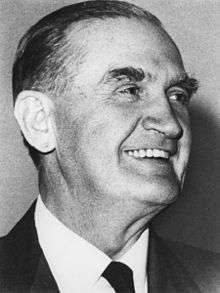 |
Country Leader 1958–71 |
Deputy Prime Minister Minister for Trade and Industry |
10 January 1968 | 5 February 1971 | 3 years, 26 days | John Gorton | ||
| Doug Anthony |  |
Country Leader 1971–84 |
Deputy Prime Minister Minister for Trade and Industry |
5 February 1971 | 10 March 1971 | 1 year, 304 days | |||
| 10 March 1971 | 5 December 1972 | William McMahon | |||||||
| Lance Barnard |  |
Labor Deputy Leader 1967–74 |
Deputy Prime Minister Minister for Defence |
5 December 1972 | 12 June 1974 | 1 year, 189 days | Gough Whitlam | ||
| Jim Cairns |  |
Labor Deputy Leader 1974–75 |
Deputy Prime Minister Treasurer |
12 June 1974 | 2 July 1975 | 1 year, 20 days | |||
| Frank Crean |  |
Labor Deputy Leader 1975 |
Deputy Prime Minister Minister for Overseas Trade |
2 July 1975 | 11 November 1975 | 132 days | |||
| Doug Anthony |  |
Country National Leader 1971–84 |
Deputy Prime Minister Minister for Trade and Industry |
12 November 1975 | 11 March 1983 | 7 years, 119 days | Malcolm Fraser | ||
| Lionel Bowen |  |
Labor Deputy Leader 1977–90 |
Deputy Prime Minister Minister for Trade Vice-President of the Executive Council Attorney-General |
11 March 1983 | 4 April 1990 | 7 years, 24 days | Bob Hawke | ||
| Paul Keating |  |
Labor Deputy Leader 1990–91 |
Deputy Prime Minister Treasurer |
4 April 1990 | 3 June 1991 | 1 year, 60 days | |||
| Brian Howe | Labor Deputy Leader 1991–95 |
Deputy Prime Minister Minister for Health Minister for Housing Minister for Community Services Minister for Local Government Minister for Regional Affairs |
3 June 1991 | 20 December 1991 | 4 years, 17 days | ||||
| 20 December 1991 | 20 June 1995 | Paul Keating | |||||||
| Kim Beazley |  |
Labor Deputy Leader 1995–96 |
Deputy Prime Minister Minister for Finance |
20 June 1995 | 11 March 1996 | 265 days | |||
| Tim Fischer |  |
National Leader 1990–99 |
Deputy Prime Minister Minister for Trade |
11 March 1996 | 20 July 1999 | 3 years, 131 days | John Howard | ||
| John Anderson | National Leader 1999–2005 |
Deputy Prime Minister Minister for Transport and Regional Development |
20 July 1999 | 6 July 2005 | 5 years, 351 days | ||||
| Mark Vaile | .jpg) |
National Leader 2005–2007 |
Deputy Prime Minister Minister for Trade Minister for Transport and Regional Services |
6 July 2005 | 3 December 2007 | 2 years, 150 days | |||
| Julia Gillard | 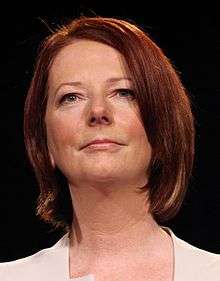 |
Labor Deputy Leader 2006–2010 |
Deputy Prime Minister Minister for Employment and Workplace Relations Minister for Education Minister for Social Inclusion |
3 December 2007 | 24 June 2010 | 2 years, 203 days | Kevin Rudd | ||
| Wayne Swan |  |
Labor Deputy Leader 2010–2013 |
Deputy Prime Minister Treasurer |
24 June 2010 | 27 June 2013 | 3 years, 3 days | Julia Gillard | ||
| Anthony Albanese |  |
Labor Deputy Leader 2013 |
Deputy Prime Minister Minister for Broadband, Communications and the Digital Economy Minister for Infrastructure and Transport |
27 June 2013 | 18 September 2013 | 83 days | Kevin Rudd | ||
| Warren Truss |  |
National Leader 2007–2016 |
Deputy Prime Minister Minister for Infrastructure and Regional Development |
18 September 2013 | 15 September 2015 | 2 years, 153 days | Tony Abbott | ||
| 15 September 2015 | 18 February 2016 | Malcolm Turnbull | |||||||
| Barnaby Joyce |  |
National Leader 2016–present |
Deputy Prime Minister Minister for Agriculture and Water Resources |
18 February 2016 | Incumbent | 293 days | |||
Living former Deputy Prime Ministers
As of December 2016, there are 11 living former Deputy Prime Ministers of Australia, the oldest being Doug Anthony (born 1929). The most recent former deputy prime minister to die was Lionel Bowen (1983–1990), on 1 April 2012.
- Doug Anthony (1971–72, 1975–83)
- Paul Keating (1990–91)
- Brian Howe (1991–95)
- Kim Beazley (1995–96)
- Tim Fischer (1996–99)
- John Anderson (1999–2005)
- Mark Vaile (2005–07)
- Julia Gillard (2007–10)
- Wayne Swan (2010–13)
- Anthony Albanese (2013)
- Warren Truss (2013–16)
Informal Deputy Prime Ministers
The office of Deputy Prime Minister was created in January 1968 but prior to that time the term was used unofficially for the second-highest ranking minister in the government.
| Name | Picture | Term of office | Political party and position | Ministerial Offices | Prime Minister | |||
|---|---|---|---|---|---|---|---|---|
| Alfred Deakin | 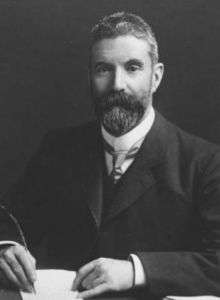 |
1901 | 1903 | Protectionist Party Deputy Leader 1901–03 |
Attorney-General Acting Prime Minister 1902 |
Edmund Barton | ||
| William Lyne |  |
1903 | 1904 | Protectionist Party Deputy Leader 1901–09 |
Minister for Trade and Customs | Alfred Deakin | ||
| Gregor McGregor |  |
1904 | 1904 | Australian Labor Party Deputy Leader 1901–14 |
Vice-President of the Executive Council | Chris Watson | ||
| Allan McLean |  |
1904 | 1905 | Protectionist Party | Minister for Trade and Customs | George Reid | ||
| William Lyne |  |
1905 | 1908 | Protectionist Party Deputy Leader 1901–09 |
Minister for Trade and Customs Treasurer |
Alfred Deakin | ||
| Gregor McGregor |  |
1908 | 1909 | Australian Labor Party Deputy Leader 1901–14 |
Vice-President of the Executive Council | Andrew Fisher | ||
| Joseph Cook |  |
1909 | 1910 | Commonwealth Liberal Party Deputy Leader 1909–13 |
Minister for Defence | Alfred Deakin | ||
| Gregor McGregor |  |
1910 | 1913 | Australian Labor Party Deputy Leader 1901–14 |
Vice-President of the Executive Council | Andrew Fisher | ||
| John Forrest | 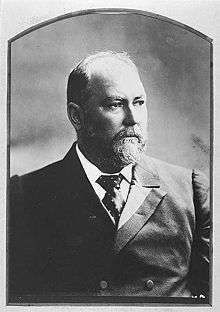 |
1913 | 1914 | Commonwealth Liberal Party Deputy Leader 1913–16 |
Treasurer | Joseph Cook | ||
| Billy Hughes |  |
1914 | 1915 | Australian Labor Party Deputy Leader 1914–15 |
Attorney-General Acting Prime Minister 1915 |
Andrew Fisher | ||
| George Pearce |  |
1915 | 1916 | Australian Labor Party Deputy Leader 1915–16 |
Minister for Defence Acting Prime Minister 1916 |
Billy Hughes | ||
| 1916 | 1917 | National Labor Party Deputy Leader 1916–17 |
||||||
| William Watt |  |
1918 | 1920 | Nationalist Deputy Leader 1918–20 |
Treasurer Acting Prime Minister 1918–19 |
|||
| Joseph Cook |  |
1917 | 1921 | Nationalist Deputy Leader 1920–21 |
Minister for the Navy Treasurer acting Prime Minister May–September 1921 |
|||
| Earle Page |  |
1923 | 1929 | Country Party Leader 1921–39 |
Treasurer | Stanley Bruce | ||
| Ted Theodore | 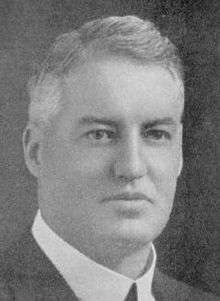 |
1929 | 1932 | Australian Labor Party Deputy Leader 1929–32 |
Treasurer | James Scullin | ||
| James Fenton |  |
1930 | 1931 | Australian Labor Party Temporary Leader 1929–32 |
Acting Prime Minister 1930–31 | James Scullin | ||
| John Latham |  |
1932 | 1934 | United Australia Party Deputy Leader 1932–34 |
Attorney-General Minister for External Affairs Minister for Industry |
Joseph Lyons | ||
| George Pearce |  |
1934 | 1934 | United Australia Party Deputy Leader 1934 |
Minister for External Affairs Minister in Charge of Territories | |||
| Earle Page |  |
1934 | 1939 | Country Party Leader 1921–39 |
Minister for Commerce Minister for Health | |||
| Archie Cameron |  |
1939 | 1940 | Country Party Leader 1939–40 |
Postmaster-General Minister for Commerce Minister for the Navy |
Robert Menzies | ||
| Arthur Fadden |  |
1940 | 1941 | Country Party Leader 1940–58 |
Minister for the Air Minister for Civil Aviation Treasurer Acting Prime Minister 1940 | |||
| Billy Hughes |  |
1941 | 1941 | United Australia Party Leader 1941–43 |
Minister for the Navy Attorney-General |
Arthur Fadden | ||
| Frank Forde |  |
1941 | 1946 | Australian Labor Party Deputy Leader 1932–46 |
Minister for the Army Minister for Defence Acting Prime Minister April–July 1944, November 1944 – January 1945, Prime Minister for one week in 1945 |
John Curtin | ||
| Ben Chifley | ||||||||
| H. V. Evatt |  |
1946 | 1949 | Australian Labor Party Deputy Leader 1946–51 |
Minister for External Affairs Attorney-General |
|||
| Arthur Fadden |  |
1949 | 1958 | Country Party Leader 1940–58 |
Treasurer | Robert Menzies | ||
| John McEwen |  |
1958 | 1967 | Country Party Leader 1958–71 |
Minister for Trade and Industry Acting Prime Minister June–July 1965 |
|||
| Harold Holt | ||||||||
References
- ↑ "Ministerial Swearing-in Ceremony". Events. Governor-General of the Commonwealth of Australia. 18 February 2016. Retrieved 19 February 2016.
- ↑ PrimeFacts: Deputy Prime Ministers of Australia
- ↑ http://primeministers.naa.gov.au/primeministers/mcmahon/before-office.aspx
- ↑ "Ministries and Cabinets". 43rd Parliamentary Handbook: Historical information on the Australian Parliament. Parliament of Australia. 2010. Retrieved 9 July 2013.
- ↑ "Deputy Prime Ministers of Australia" (PDF). Museum of Australian Democracy. Retrieved 27 July 2013.